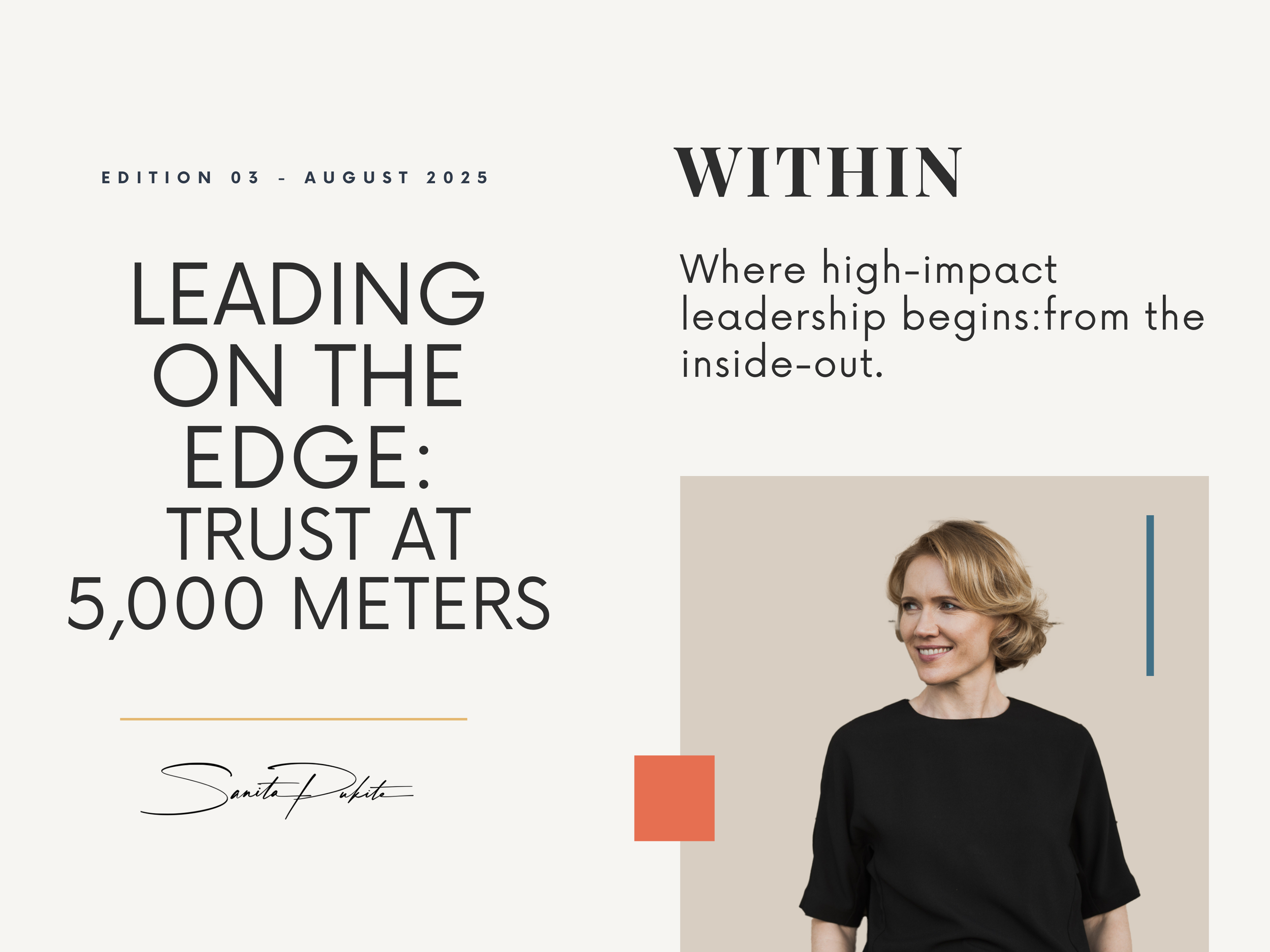Leading on the Edge: Trust at 5,000 meters
Published by Sanita Pukite - on August 20, 2025
Trust at altitude
A few weeks ago a group of us summitted Mt. Ararat (Turkey's highest mountain). What stayed with me most from this trip wasn’t just the summit. It was how quickly trust formed between us.
We started as a mixed group of classmates, friends and acquaintances and over the matter of just 3 days we became a group who helped, supported and lifted each other.
One teammate nearly collapsed from exhaustion when reaching the summit and others instinctively reached out to help. When the winds became so disorienting, that I could see no direction anymore - our guide stepped in - quick, responsive, grounded and got us quickly down - back to sun and safety.
In these moments, one became all, and all became one.
As I reflected on the trip, I drew parallels to leadership and organisations.
The myth of “Trust takes time”
We often say trust is slow, earned over months or years. But this climb taught me something different:
Fast trust is possible, when it’s grounded in purpose and presence.
So how did strangers from different countries, speaking different languages, with vastly different life stories, form trust so quickly?
It wasn’t magic. It was: Shared values and excitement about the journey.
A common commitment to reach the top.
A desire to stretch and prove ourselves, especially when it got hard.
Open vulnerability, sharing reflections while resting on warm, sun-soaked stones
Back in June, I studied Dynamic Teaming with Harvard's Prof. Amy Edmondson. What happened on Mt. Ararat was a case study in her research:
“Teaming” is the ability to collaborate quickly in high-stakes, uncertain environments. (Source) We didn’t need months of bonding. We needed shared clarity, mutual care, and real presence.
Leadership in micro-moments
Leadership isn’t a title. It’s an act. Leadership shows up in micro-moments and nowhere it can be experienced as well as during a mountain climb:
Someone stumbles and you catch them.
The wind rises and someone loses control of their legs.
You place a hand on someone’s back and whisper, “I’ve got you.”
It shows up when we lead with presence and feeling the moment vs. just about the summit and the performance.
Cognitive Overload is real.
By the time we reached the summit, our minds were fried: gear, pacing, snow, hydration, doubt. Add 35 km/h wind, and some of us felt lost.
Psychologists call this cognitive overload: when complexity + pressure exceed our brain’s processing capacity. We shut down. It is not a new concept. Cognitive Load Theory was developed by Australian cognitive psychologist John Sweller back in 1988, however it is as relevant today as it was back then. (Source)
And this is not just a mountain thing. Transferred to the executive meeting room, it is today’s leadership reality:
Rapid decisions.
Fragmented attention.
Little time to plan.
On Mt. Ararat, our guide didn’t just walk first. He designed the climb.
Sequenced it in stages that felt accessible,
Divided the group to reduce risk,
Set a pace that was doable,
Descended to support stragglers, then climbed again,
Created clarity in chaos on our way down.
Great leaders do the same in meetings. They design for clarity, not control.
Practice takeaway: 6-step guide to run better meetings.
Inspired by Amy C. Edmondson + John Sweller’s research, here’s a 6-step guide to reducing cognitive overload in meetings:
1. Pre-train the room. Send 3 bullets 24h in advance (decision, options, criteria). Clear context creates calm. It aligns minds before the meeting begins.
2. One frame, one slide. Show the question, options, and criteria in one visual. Clarity over clutter. Reduce mental juggling.
3. Round of voices. Ask: “What might we miss?” before the debate. Draw out hidden insight. Capture dissent before discussion.
4. Name assumptions. Ask: “What belief is driving my view?” before defending it. Surface the story behind the stance.
5. Respond with curiosity. When challenged, pause. Ask, “Say more?” Normalize learning in the moment.
6. Use a worked example Anchor choices in real-life data or lived experience. Examples reduce ambiguity. Stories stick.
When we reduce noise, sequence complexity, and stay grounded, we lead smarter - together.
Why this works?
Sweller, Cowan, and Baddeley (source) show that cognitive overload shuts down our ability to think clearly.
Amy C. Edmondson’s research on teaming demonstrates how teams learn and adapt in real time when clarity and psychological safety are designed into the process.
The skill leaders need most today is knowing how to stay grounded when everything shifts. This isn’t about theory. It’s about being and becoming the leader others feel safe to follow, especially when the stakes are high.
Reflection Corner:
Where are you being called to create trust: not through words, but through how you show up?
What if your presence became the anchor others lean on?
Until next time: Keep climbing. Keep grounding. Keep leading.
(This was part 2 of two series. Read Part 1 here. )
Warmly,
Sanita
P.S. In the next edition, we’ll go deeper: the biology and psychology of trust.
How can I help?
✧ Explore a signature workshop. Bring the High-Impact Leadership Series™ to your organization - experiential learning workshops on clarity, presence, influence, and courageous leadership under pressure. [Enquire here]
✧ Book private coaching. Step into your next chapter with bespoke executive coaching. For senior leaders navigating transition, pressure, or reinvention. [Schedule a chemistry call.]
✧ Want to follow the journey? Subscribe to the LinkedIn newsletter or join my Email reflections - personal, practical, and a behind-the-scenes look at building bold leadership from the inside out.
Let’s shape the kind of leadership the future is calling for - grounded, resonant, and deeply human.


